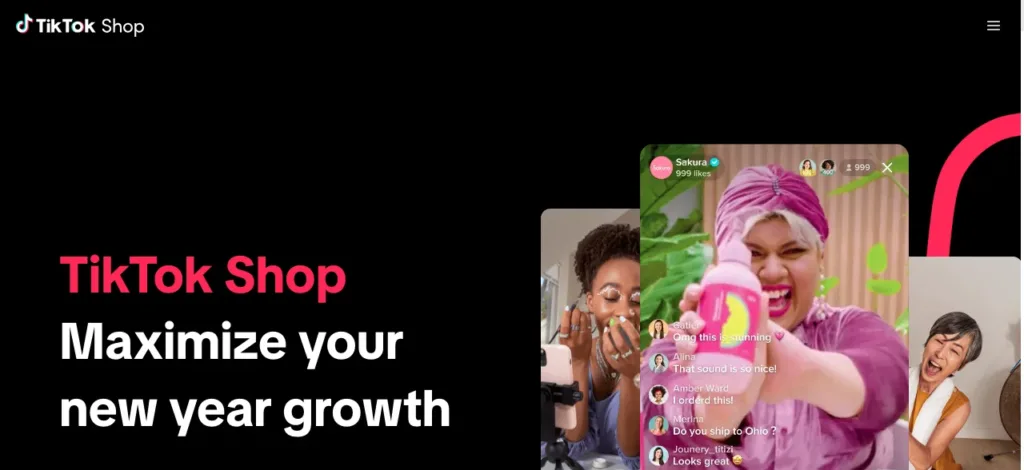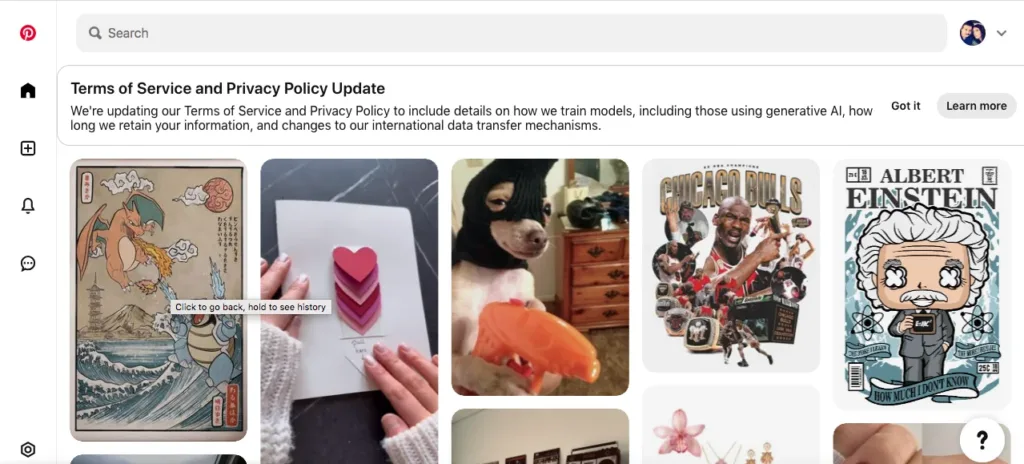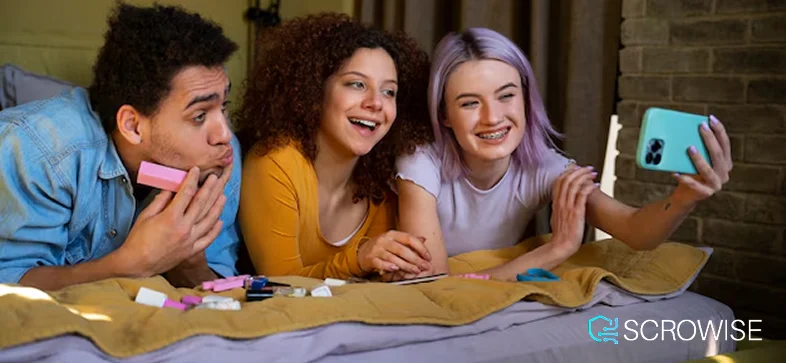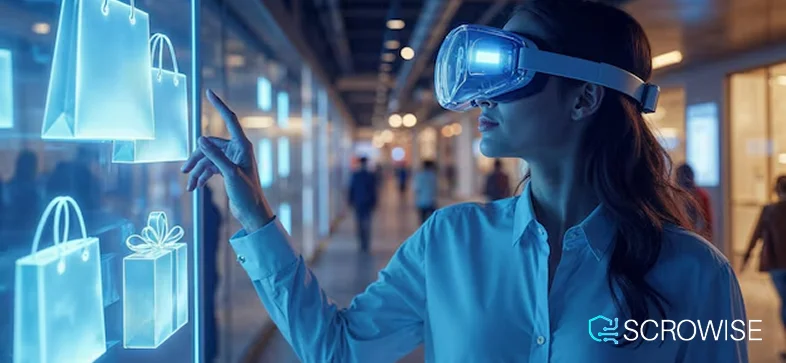Imagine this: A 19-year-old is scrolling through TikTok. They stop on a video where someone is opening a sunset lamp. With just three taps, that same lamp is going to their doorstep. They didn’t need to go to a website or leave the app.
This is not shopping like it was before. This is social shopping, and it is changing how Gen Z finds and buys products.
Generation Z, born from 1997 to 2012, has always lived in a world full of smartphones and social media. For them, there is no clear line between entertainment, connecting with friends, and shopping. These aspects feel the same.
In this new world, brands aren’t just fighting for space on shelves or ad views. They are competing for real moments of connection in feeds with friends, creators, and entertainment.
Let’s look at how social shopping for gen Z is changing trade for those who value authenticity, community, and effortless experiences above all else.
Understanding Gen Z’s Digital Shopping Behavior

Gen Z approaches shopping fundamentally differently than previous generations. For them, shopping isn’t a separate activity, it’s naturally integrated into their social media experience.
How Social Media Shapes Gen Z Purchase Decisions
For Gen Z, finding new products happens as they use content. Unlike older generations who may look for products on purpose, Gen Z finds items while enjoying the content they like.
A surprising 97% of Gen Z shoppers use social media to find where to shop. When they see something they like, they want to buy it right away.
What makes this different from regular ecommerce? It’s about context and trust. When Gen Z sees products being used by real people in real life, they are more likely to buy.
This generation also buys based on what they believe in. A recent IBM study found that 68% of Gen Z shoppers want their choices to match their values. They look into these values by checking social media.
Social proof doesn’t just affect their choices—it controls them. A product suggested by someone they trust seems checked ahead of time. This lowers the chance of feeling regret after buying.
5 Key Differences Between Gen Z and Millennial Shoppers

While Millennials pioneered digital shopping, Gen Z has transformed it:
- Speed expectation: Gen Z expects near-instant gratification with faster shipping, quicker checkout, and immediate customer service.
- Platform preference: While Millennials gravitate toward Facebook and Instagram, Gen Z prefers TikTok, Snapchat, and emerging platforms that offer more visual, bite-sized content.
- Brand relationships: Millennials might develop brand loyalty; Gen Z develops creator loyalty. They follow people, not logos.
- Payment preferences: Gen Z embraces buy-now-pay-later options (like Afterpay) and digital payment methods at significantly higher rates than Millennials.
- Authenticity threshold: Millennials might accept polished marketing; Gen Z has finely-tuned authenticity detectors and prefers raw, unfiltered content.
As one 18-year-old shopper put it: “I don’t follow brands. I follow people whose style I like, and if they happen to mention where something’s from, that’s how I discover products.”
The Psychology Behind Social Validation in Shopping Choices
The psychological underpinnings of social shopping run deep. Gen Z has grown up in a world where social validation is quantifiable through likes, shares, and comments.
This translates directly to shopping behavior. When a product receives visible validation from peers or trusted creators, it triggers several psychological responses:
- Fear of missing out (FOMO): When products trend on social commerce platforms, Gen Z feels urgency to participate.
- Social identity reinforcement: Purchasing products promoted by communities they identify with strengthens their sense of belonging.
- Risk reduction: Seeing others’ positive experiences reduces the perceived risk of making a poor purchase.
A Harvard Business Review study found that Gen Z consumers are 1.5 times more likely to follow a brand that their friends also follow, showing how deeply intertwined social validation and commerce have become.
Popular Social Shopping Platforms Capturing Gen Z Attention

Social platforms aren’t just places to connect anymore—they’re full-fledged shopping destinations with unique commerce experiences.
Instagram Shopping: Visual Commerce in Action
Instagram has transformed from a photo-sharing app into a visual shopping mall. The platform’s shopping features now allow users to discover, browse, and purchase products without ever leaving the app.
Key features driving Gen Z engagement include:
- Shop tab: A dedicated shopping destination within the app, algorithmically curated based on user interests and behavior.
- Shopping tags: Product tags embedded directly in posts and Stories that display price and lead to in-app checkout.
- Collections: Allowing users to save products they’re interested in for later purchase.
- Instagram Checkout: Completing purchases without leaving the platform.
The visual nature of Instagram makes it particularly powerful for fashion, beauty, and lifestyle brands. A recent study showed that 70% of shoppers look to Instagram for their next purchase, with Gen Z making up the largest segment.
Beauty brand Glossier is a prime example of Instagram Shopping success, building their entire business model around Instagram-friendly products and packaging that begs to be shared.
TikTok Shop: How Short-Form Video Content Drives Purchases

TikTok has rocketed from entertainment platform to commerce powerhouse in record time. The platform’s short-form video format creates the perfect environment for product discovery.
The magic of TikTok commerce lies in:
- #TikTokMadeMeBuyIt: This hashtag has over 25 billion views and has created countless viral products, from leggings to cleaning supplies.
- TikTok Shop: An in-app marketplace where creators can tag products in videos, with seamless checkout.
- Live shopping: Real-time product demonstrations with interactive features like Q&A.
The platform’s algorithm excels at putting products in front of interested users, even when they weren’t actively shopping. When a product goes viral on TikTok, the results are immediate and dramatic.
CeraVe skincare experienced this firsthand when creator Hyram Yarbro’s recommendations led to global product shortages, demonstrating TikTok’s unprecedented power to drive Gen Z purchasing decisions.
Pinterest’s Evolution from Inspiration to Transaction Hub

Pinterest has always occupied a unique space: catching consumers in planning mode rather than browsing mode. Now, the platform has evolved to capitalize on this intent-rich environment.
For Gen Z shoppers, Pinterest offers:
- Shoppable Pins: Product pins with up-to-date pricing, availability, and direct links to purchase.
- Shopping List: A dedicated place to save and organize products they’re considering.
- Visual search: Using the camera to find visually similar products to anything they see in the real world.
- Try-on features: AR technology allowing users to virtually test makeup and other products.
While Pinterest’s user base skews slightly older, the platform is gaining traction with Gen Z through its sustainability focus and less competitive, more positive environment.
A Pinterest executive recently revealed that Gen Z users save 11 times more shopping-related content than older users, suggesting they use the platform extensively for purchase planning.
Influencer Marketing: The New Retail Storefront

For Gen Z, influencers aren’t just product promoters—they’re trusted shopping advisors whose recommendations carry more weight than traditional advertising.
Why Gen Z Trusts Creator Recommendations Over Brands
Trust in traditional advertising has plummeted, especially among younger consumers. Gen Z places their trust in individuals rather than institutions.
The numbers are clear:
- 63% of Gen Z trusts influencer recommendations over celebrity endorsements
- 76% follow at least one creator who has influenced them to make a purchase
- 44% have made a purchase based solely on a creator’s recommendation
This trust stems from perceived authenticity. Creators feel like peers who share honest opinions rather than salespeople pushing products. The relatability factor is crucial—Gen Z wants to see products used by people who look like them and share their values.
As one Gen Z shopper put it: “When a brand tells me their product is great, that’s their job. When someone I follow shows how a product actually works in their everyday life, good or bad, that’s valuable information.”
Micro vs. Macro Influencers: Which Drives More Conversions?

While celebrity influencers with millions of followers might seem like the obvious choice, data shows micro-influencers (typically 10,000-100,000 followers) often drive higher conversion rates for Gen Z audiences.
A recent study found that micro-influencers generate 60% higher engagement rates and drive 22.2% more weekly conversions than macro-influencers.
Why do smaller creators convert better?
- Higher trust factor: Their communities perceive them as more authentic and less commercialized.
- Niche expertise: They often focus on specific areas, making their recommendations seem more knowledgeable.
- Engagement quality: They typically respond to comments and build actual relationships with followers.
- Relatability: They present more attainable lifestyles that Gen Z can see themselves in.
Successful brands are building “creator clouds”—networks of micro-influencers across various niches—rather than relying on a few big-name partnerships.
Authentic Content Creation Strategies That Convert Followers
The most effective creator content for Gen Z follows specific patterns that build trust and drive conversion:
- Behind-the-scenes content: Showing how products are made or designed adds authenticity and transparency.
- Honest reviews: Including genuine drawbacks alongside benefits (rather than purely positive reviews) significantly increases trust.
- Comparison content: Showing multiple options and explaining the genuine pros and cons of each.
- Day-in-the-life integration: Demonstrating how products naturally fit into daily routines.
- Before/after demonstrations: Providing visual evidence of product effectiveness.
E.l.f. Cosmetics exemplifies this approach, partnering with creators for unscripted content that focuses on authentic usage rather than marketing messages. Their sales have grown over 50% year-over-year, driven largely by Gen Z social shoppers.
The Power of User-Generated Content in Purchase Decisions

Beyond professional creators, everyday consumers now play a crucial role in the social shopping ecosystem through user-generated content (UGC).
How Reviews and Testimonials Shape Gen Z Confidence
Gen Z approaches purchases with caution, researching extensively before committing. User reviews form the backbone of this research process.
For Gen Z shoppers:
- 91% read at least one review before making a purchase
- 40% won’t buy a product if it has no reviews, regardless of how interested they were initially
- 78% specifically look for negative reviews to understand worst-case scenarios
What makes reviews particularly powerful for Gen Z is their perceived objectivity. Unlike brand messaging or even influencer content (which may be sponsored), reviews from everyday users feel unbiased.
Smart brands are bringing reviews directly into the social shopping experience, embedding user feedback into shoppable posts and creating dedicated spaces for customer testimonials within social platforms.
Leveraging Hashtag Challenges to Boost Product Visibility

Hashtag challenges transform passive consumers into active participants and content creators. For Gen Z, participating in product-centered challenges feels less like engaging with advertising and more like joining a cultural moment.
Successful challenge campaigns share these elements:
- Low barrier to entry: Simple enough that anyone can participate without special skills or equipment.
- Clear connection to product benefits: The challenge should naturally showcase what makes the product special.
- Opportunity for creative expression: Leaving room for personal interpretation and customization.
- Community recognition: Featuring participant content builds engagement.
E.l.f. Cosmetics’ #eyeslipsface TikTok challenge generated over 7 billion views and drove a 200% increase in traffic to their website—demonstrating how effective UGC challenges can be for engaging Gen Z shoppers.
Creating Shareable Moments Throughout the Shopping Journey
Smart brands are engineering physical and digital experiences specifically designed to be shared on social platforms.
These “Instagram moments” convert customers into voluntary marketers:
- Unboxing experiences: Thoughtful packaging design that begs to be filmed and shared.
- Digital sharing prompts: Post-purchase emails with suggested captions and hashtags.
- In-store photo opportunities: Physical spaces designed specifically for social content creation.
- Digital collectibles: Shareable assets that commemorate purchases or experiences.
Glossier’s showrooms exemplify this approach with their highly photographable interiors and mirrors featuring shareable quotes, turning each visitor into a potential content creator for the brand.
Social Commerce Features That Drive Gen Z Engagement

The technical infrastructure of social shopping continues to evolve, with platforms introducing features that reduce friction and enhance the shopping experience.
Live Shopping Events: The Digital Shopping Mall Experience
Live shopping merges entertainment, education, and commerce into interactive shopping experiences that particularly resonate with Gen Z.
What makes live shopping effective:
- Real-time interaction: Viewers can ask questions and get immediate responses, addressing hesitations on the spot.
- Limited-time offers: Flash deals during broadcasts create urgency and drive immediate conversion.
- Community experience: The shared viewing experience creates a sense of event and community.
- Authentic demonstrations: Products are shown in action rather than in static images.
In China, live shopping already generates billions in revenue. Western platforms are now rapidly adopting similar features, with Instagram, TikTok, and YouTube all investing heavily in live commerce capabilities.
Beauty brand Kaja saw a 391% increase in sales during their first TikTok live shopping event, with the majority of purchasers being first-time customers from Gen Z.
In-App Checkout: Reducing Friction in the Buying Process

For Gen Z, leaving an app to complete a purchase feels like an unnecessary hassle. In-app checkout features keep users in their comfort zone, streamlining the path from discovery to purchase.
The impact is significant:
- Conversion rates increase by up to 30% when checkout happens within the platform
- 27% of Gen Z has abandoned a purchase because they were redirected to an external site
- Average cart value increases when payment details are saved within trusted social platforms
Instagram and TikTok now offer fully integrated checkout for approved merchants, allowing users to complete purchases without ever leaving their feeds. Pinterest and Snapchat are rapidly developing similar capabilities.
AR Try-Before-You-Buy: Virtual Testing Before Purchase
Augmented reality bridges the gap between digital convenience and physical experience—a perfect solution for Gen Z shoppers who value both.
AR shopping features now allow users to:
- Virtually try on makeup, glasses, and accessories
- Place furniture and decor items in their actual spaces
- See how clothing might look on their body type
- Test different colors and configurations of products
Snapchat has been a leader in this space, with its AR technology now supporting over 250 million daily users. Their shopping lenses have proven particularly popular with Gen Z, with beauty brands reporting try-on rates 10x higher than traditional product pages.
IKEA’s AR Place app demonstrates the power of this technology, allowing shoppers to see exactly how furniture would fit in their spaces. The result? A 40% reduction in returns and significantly higher purchase confidence.
Building Community Around Products and Brands

For Gen Z, shopping isn’t just transactional—it’s about identity and belonging. Successful brands are creating communities where commerce is just one aspect of a larger relationship.
How Values-Based Marketing Resonates with Gen Z Shoppers
Gen Z doesn’t just buy products; they buy into brand values. Their purchasing decisions are deeply intertwined with their personal ethics and identity.
The statistics are revealing:
- 82% of Gen Z prefers to buy from brands that align with their values
- 45% have boycotted brands based on ethical concerns
- 76% research a company’s position on social issues before making significant purchases
Successful brands clearly communicate their stance on issues that matter to Gen Z:
- Environmental sustainability
- Social justice and equality
- Labor practices and worker treatment
- Inclusivity and representation
- Mental health advocacy
Patagonia exemplifies this approach, building their entire business model around environmental activism. Their dedication to these values has made them a favorite among Gen Z consumers despite premium pricing.
Creating Exclusive Social Shopping Communities and Perks

Gen Z values exclusivity and insider status. Brands are creating members-only social spaces where shopping is just one benefit among many.
Effective community-building strategies include:
- Private Discord servers for product discussion and early access
- Brand ambassador programs that reward community participation
- Exclusive product drops announced only through community channels
- Behind-the-scenes content shared only with community members
- Input on product development through polls and feedback sessions
Outdoor Voices’ #DoingThings community encourages members to share their active lifestyles, creating a sense of belonging that transcends the products themselves. Their community-first approach has helped them build significant loyalty among Gen Z consumers.
Turning Customers into Brand Advocates Through Social Platforms
The ultimate goal of social shopping communities is to transform customers into advocates who voluntarily promote products to their own followers.
Strategies that effectively cultivate brand advocates include:
- Recognition systems: Highlighting community member content on official channels.
- Reward structures: Offering points, perks, or early access based on social sharing.
- Creation tools: Providing templates, filters, and assets that make sharing easier.
- Social impact opportunities: Letting customers participate in giving back through their purchases and advocacy.
Glossier’s representative program demonstrates this approach perfectly. By turning passionate customers into part-time ambassadors who share personalized discount codes, they’ve built a network of genuine advocates who drive significant sales through authentic recommendations.
Navigating Privacy Concerns in the Social Shopping Era

As social shopping grows, so do concerns about data usage and privacy, particularly among the surprisingly privacy-conscious Gen Z.
Balancing Personalization with Data Privacy for Gen Z
Gen Z presents a fascinating paradox: they expect highly personalized experiences but are increasingly concerned about how their data is collected and used.
Recent research shows:
- 88% of Gen Z values personalized recommendations
- Yet 65% are concerned about how brands collect and use their data
- 72% regularly take actions to limit data tracking
This creates a challenging balance for brands and platforms. The solution lies in value exchange, ensuring that when Gen Z shares data, they receive clear benefits in return.
Successful approaches include:
- Preference centers: Allowing users to explicitly tell brands what they want rather than relying solely on tracking.
- Progressive disclosure: Collecting only necessary information upfront and gradually requesting more as the relationship develops.
- Transparent AI: Clearly explaining how algorithms make recommendations.
- Data visualization: Showing users what information has been collected and how it’s being used.
Transparent Practices That Build Trust with Young Consumers

Transparency isn’t just a nice-to-have for Gen Z—it’s expected. Brands that clearly communicate their data practices build significantly more trust.
Effective transparency practices include:
- Plain-language privacy policies: Moving beyond legal jargon to clearly explain data usage.
- Contextual consent: Asking for permissions at relevant moments with clear explanations of benefits.
- Control mechanisms: Providing easy ways to opt out, delete data, or modify settings.
- Security explanations: Communicating how customer data is protected.
Beauty brand Deciem exemplifies transparency through their “The Abnormal” communication style, which extends to clear explanations of their data practices. This approach has helped them build extraordinary trust with their predominantly Gen Z customer base.
Future of First-Party Data in Social Commerce Strategy
As third-party cookies disappear and privacy regulations tighten, first-party data (information collected directly from customers with their consent) is becoming the gold standard for social commerce.
Smart brands are:
- Building owned social communities where they can collect data directly
- Creating a valuable reason for customers to share information voluntarily
- Implementing zero-party data strategies where customers proactively share preferences
- Developing more sophisticated CRM systems that respect privacy while delivering personalization
Skin care brand The Ordinary demonstrates this approach by collecting detailed skin concerns and preferences directly from customers, then using this information to provide personalized recommendations—all while maintaining strict privacy standards.
Future Trends: What’s Next for Social Shopping

The social shopping landscape continues to evolve rapidly. Understanding emerging trends helps brands stay ahead in capturing Gen Z’s attention and wallet share.
The Metaverse and Virtual Shopping Experiences Emerging
The metaverse—persistent, shared virtual spaces—represents the next frontier in social shopping for Gen Z.
Early metaverse shopping experiences suggest several promising directions:
- Virtual stores: Digital retail environments that mimic or enhance physical shopping experiences.
- Digital fashion: Virtual clothing and accessories for avatars, already a multi-million dollar market.
- Social shopping parties: Bringing friends together in virtual spaces to shop collaboratively.
- Virtual try-on: Advanced avatar technology that shows how products would look on the actual customer.
Brands like Nike (with Nikeland in Roblox) and Forever 21 (with Shop City) are already establishing metaverse retail presences that allow users to socialize, play, and shop simultaneously—a combination particularly appealing to Gen Z.
Social Shopping and Cryptocurrency: A Natural Partnership?

The overlap between cryptocurrency enthusiasts and Gen Z social shoppers creates interesting opportunities for brands willing to explore this space.
Emerging developments include:
- Social tokens: Community-specific currencies that offer special access or benefits.
- NFT product authentication: Using blockchain technology to verify product authenticity and ownership.
- Crypto payment options: Allowing purchases using cryptocurrency within social platforms.
- Tokenized loyalty programs: Converting traditional points systems into tradable tokens.
While still emerging, these technologies appeal to Gen Z’s interest in digital ownership and community belonging. Brands like Gucci have experimented with NFT collections, finding significant interest among younger consumers.
7 Predictions for Social Commerce Evolution by 2025
Based on current trends and technology development, here are seven predictions for social shopping’s near future:
- Live shopping will become mainstream in Western markets, representing at least 20% of social commerce revenue.
- Social platforms will develop specialized shopping search engines that compete directly with Amazon and Google.
- Virtual shopping assistants powered by AI will help navigate social shopping experiences.
- Cross-platform shopping carts will allow users to save items from multiple platforms and checkout in one place.
- Social shopping will expand to service businesses, not just physical products.
- Augmented reality will become standard for certain product categories like furniture, fashion, and beauty.
- Creators will evolve into full retail channels with their own exclusive product lines and shopping destinations.
For brands targeting Gen Z, staying ahead of these trends isn’t optional—it’s essential for remaining relevant in an increasingly social commerce world.
Social shopping for gen Z isn’t just a new channel, it’s their primary shopping experience. By understanding how this generation discovers, evaluates, and purchases products through social connections, brands can create more authentic, engaging, and effective commerce strategies.
The most successful brands won’t just sell to Gen Z, they’ll build communities where commerce is a natural extension of connection, entertainment, and shared values.
The future of retail isn’t about transactions; it’s about relationships. And for Gen Z, those relationships live on social platforms.
FAQs
What is the shopping trend for Gen Z?
Gen Z prefers social shopping on platforms like TikTok, Instagram, and Pinterest, valuing convenience, influencer recommendations, and community-driven experiences.
How Gen Z shopping habits differ from Millennials?
Gen Z is more likely to make impulse purchases through social media, prioritize sustainability, and engage with brands that align with their values, while Millennials often research purchases more thoroughly.
What generation has the most spending power?
Millennials currently have the most spending power, but Gen Z is rapidly growing in influence and is expected to drive future consumer trends.

